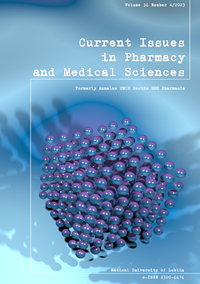Evaluation of parenteral injection skills of medical undergraduates on mannequins in a tertiary care teaching hospital in South India – A cross-sectional study
DOI:
https://doi.org/10.2478/cipms-2023-0032Keywords:
pharmacology, parenteral injections, mannequins, OSPEAbstract
Appropriate knowledge and expertise of parenteral injection is vital in the medical field. Hence we impart training on mannequins before the students practice on patients. This study was conducted to evaluate the skill exhibited by the students in parenteral injection skills, namely intravenous, intramuscular, intradermal and subcutaneous injections. The students were assessed for step based on the pre-validated check list created for Objective Structured Practical Examination. In this study, 16 % of the students failed to check the prescription order before starting the procedure. The name and the expiry date of the drug was not checked by 22 % of the students. Hundred percent of the students sterilized their hands. Loading of drug was done properly by 80 % of the students and 88 % of the students checked for air bubbles in the syringe and removed them properly. The site for injection was not sterilized by 26 percent of the students. Tourniquet was not applied by 19 percent of the students and 28 % of the students did not hold the bevel up during insertion for intravenous route. The steps where frequent faltering happened needs to be emphasized for them to perform better in a more efficient manner during the summative assessment as well as for future practice.
References
1. Shah N, Desai C, Jorwekar G, Badyal D, Singh T. Competency-based medical education: An overview and application in pharmacology. Indian J Pharmacol. 2016;48(Suppl 1):S5-S9.
2. Basheer A. Competency-based medical education in India: Are we ready? J Curr Res Sci Med. 2019;5:1-3.
3. Medical Council of India. Competency Based Undergraduate Curriculum for the Indian Medical Graduate. 2018:1-3. [https://www.mciindia.org/CMS/information-desk/for-colleges/ug-curriculum]
4. Katz LM, Finch A, McKinnish T, Gilliland K, Tolleson-Rinehart S, Marks BL. Teaching procedural skills to medical students: A pilot procedural skills lab. Educ Health (Abingdon). 2017;30(1):79-83.
5. Huo B, MacNevin W, Smyth M, Miller SG. Medical student comfort with procedural skills performance based on elective experience and career interest. Cureus. 2020;12(12):e12374.
6. King KC, Strony R. Needlestick. In: StatPearls. Treasure Island (FL): StatPearls Publishing; 2022. [https://www.ncbi.nlm.nih.gov/books/NBK493147/]
7. Denault D, Gardner H. OSHA Bloodborne Pathogen Standards. In: StatPearls. Treasure Island (FL): StatPearls Publishing; 2022.
8. Makmor-Bakry M, Azmi N, Ali AM. Mannequin-simulator as a new teaching and learning method in performance-based pharmaco-therapy. Indian J Pharm Edu Res. 2013;47(3):1-5.
9. Shaifali I, Ahsan M, Khurram Mallick A, Professor A. A study on objective structured practical examination ( OSPE ) as a tool for assessment of medical students. IJBAMR. 2016;(5):784-90.
10. Prasad HLK, Prasad HVK, Sajitha K, Bhat S, Shetty KJ. Comparison of Objective Structured Practical Examination (OSPE) versus conventional pathology practical examination methods among the second-year medical students-a cross-sectional study. Med Sci Educ. 2020;30(3):1131-5.
11. Shenoy PJ, Kamath P, Sayeli V, Pai S. Standardization and validation of objective structured practical examination in pharmacology: Our experience and lessons learned. Indian J Pharmacol. 2017;49(4):270-4.
12. Malhotra SD, Shah KN, Patel VJ. Objective structured practical examination as a tool for the formative assessment of practical skills of undergraduate students in pharmacology. J Educ Health Promot. 2013;2:53.
13. Shipra J, Ruchika K, Pushkar M, Prerna G. Introduction and evaluation of objective structured practical examination as an assessment tool in pharmacology for second year medical students. JCDR. 2021;15(3):FC01-FC04.
14. Vishwakarma K, Sharma M, Matreja PS, Giri VP. Introducing objective structured practical examination as a method of learning and evaluation for undergraduate pharmacology. Indian J Pharmacol. 2016;48(Suppl 1):S47-S51.
15. Feroze M, Jacob AJ. OSPE in pathology. Indian J Pathol Microbiol. 2002;45(1):53-7.
16. Singh G, Singh R. Objective structured practical examination: A tool design to gauge the perception and performance of the undergraduate medical students for Gram stain. J Med Sci Health. 2020;6(2):19-24.
Downloads
Published
Issue
Section
License
Copyright (c) 2023 Authors

This work is licensed under a Creative Commons Attribution-NonCommercial-NoDerivatives 3.0 Unported License.


